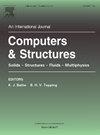Multiscale characterization of the mechanics of curved fibered structures with application to biological and engineered materials
IF 4.4
2区 工程技术
Q1 COMPUTER SCIENCE, INTERDISCIPLINARY APPLICATIONS
引用次数: 0
Abstract
Curved fibered structures are ubiquitous in nature and the mechanical behavior of these materials is of pivotal importance in the biomechanics and mechanobiology fields. We develop a multiscale formulation to characterize the macroscopic mechanical nonlinear behavior from the microstructure of fibered matrices. From the analysis of the mechanics of a randomly curved single fiber, a fibered matrix model is built to determine the macroscopic behavior following a homogenization approach. The model is tested for tensile, compression and shear loads in different applications. The presented approach naturally recovers instabilities at compression as well as the strain stiffening regime, which are observed experimentally in the mechanical behavior of collagen matrices. Indeed, it was found that the bending energy associated to fiber unrolling, is the most important source of energy developed by fibers for the analyzed cases in tensile and shear in all deformation regions (except the strain stiffening region), whereas bending energy dominates at compression too during buckling. The proposed computational framework can also be used to perform multiscale simulations in engineered fibered materials. Therefore, the developed methodology may be an interesting and complementary tool to characterize the nonlinear behavior and evolution of curved fibered structures present in biology and engineering.
弯曲纤维结构力学的多尺度表征及其在生物和工程材料中的应用
弯曲纤维结构在自然界中无处不在,这些材料的力学行为在生物力学和力学生物学领域具有举足轻重的意义。我们开发了一个多尺度公式来表征纤维基体微观结构的宏观力学非线性行为。通过对随机弯曲单纤维的力学分析,采用均匀化方法建立了纤维矩阵模型,以确定其宏观行为。该模型在不同的应用中进行了拉伸、压缩和剪切载荷的测试。所提出的方法自然恢复不稳定的压缩以及应变硬化制度,这是在实验中观察到的胶原基质的力学行为。事实上,研究发现,在所有变形区域(应变强化区域除外)中,与纤维展开相关的弯曲能是纤维产生的最重要的能量来源,而屈曲过程中,弯曲能在压缩中也占主导地位。所提出的计算框架也可用于在工程纤维材料中执行多尺度模拟。因此,所开发的方法可能是表征生物学和工程中存在的弯曲纤维结构的非线性行为和进化的有趣和补充工具。
本文章由计算机程序翻译,如有差异,请以英文原文为准。
求助全文
约1分钟内获得全文
求助全文
来源期刊

Computers & Structures
工程技术-工程:土木
CiteScore
8.80
自引率
6.40%
发文量
122
审稿时长
33 days
期刊介绍:
Computers & Structures publishes advances in the development and use of computational methods for the solution of problems in engineering and the sciences. The range of appropriate contributions is wide, and includes papers on establishing appropriate mathematical models and their numerical solution in all areas of mechanics. The journal also includes articles that present a substantial review of a field in the topics of the journal.
 求助内容:
求助内容: 应助结果提醒方式:
应助结果提醒方式:


